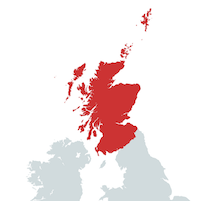
Map by mapchart.net - Some rights reserved.
Location
near Dunbeg, Argyll and Bute, Scotland
Description
Dunstaffnage Castle is situated about 3 miles from Oban in the Argyll and Bute area of western Scotland. The castle is built on a rocky promontory at the entrance to Loch Etive, and is surrounded on three sides by sea. The castle dates back to the 13th century and was built by the MacDougall lords of Lorn. It has been held since the 15th century by the Clan Campbell. Dunstaffnage Castle an irregular quadrangle with rounded towers at three corners. The walls are coursed rubble, with sandstone dressings, and are up to 60 feet high including the bedrock platform. The walls are up to 10 feet thick. A parapet walk once went around the walls, and has been partially restored. Arrow slits, later converted into gunloops, are the only openings in the walls. Three round towers were built on the north, east, and west. The north tower is the largest and was three or four storeys tall. The west tower was barely taller than the curtain wall and could only be entered via the parapet walk. The basement level contains a pit prison. The east tower was rebuilt in the late 15th century as a gatehouse (replacing an earlier round tower). The gatehouse is a four-storey tower house, with the entrance passage running through it. The present approach to the gate is by a stone stair, replacing an earlier drawbridge. Dunstaffnage is maintained by Historic Scotland, and is open to the public, although the 16th century gatehouse is private property.
History
Robert Bruce defeated the Clan MacDougall at the Battle of the Pass of Brander in 1308 or 1309, and took control of Dunstaffnage Castle. James I seized the castle in 1431, following the Battle of Inverlochy, as his enemies were hiding inside. James III granted Dunstaffnage to Colin Campbell, 1st Earl of Argyll in 1470. The Campbells were loyal allies of the king, and Dunstaffnage was used as a base for government soldiers during the 15th and 16th centuries. James IV visited Dunstaffnage on two occasions. During the Jacobite risings of 1715 and 1745, the castle was occupied by government troops. Flora MacDonald, who helped Bonnie Prince Charlie to escape from Scotland, was briefly imprisoned here while en route to imprisonment in London. In 1810 a fire gutted the castle. Restoration work was undertaken in 1903 by the Duke of Argyll. In 1958 the castle was handed into state care and is now a Historic Scotland property.
Legends
A ghost, known as the "Ell-maid of Dunstaffnage", is said to haunt the castle.
Other Castles in the Area
Ardtornish Castle, Highland
Barcaldine Castle, Argyll and Bute
Castle Stalker, Argyll and Bute
Duart Castle, Argyll and Bute
Dunollie Castle, Argyll and Bute
Gylen Castle, Argyll and Bute
Innis Chonnel Castle, Argyll and Bute
Inveraray Castle, Argyll and Bute
Kinlochaline Castle, Highland
Torosay Castle, Argyll and Bute
|
|
|
|

